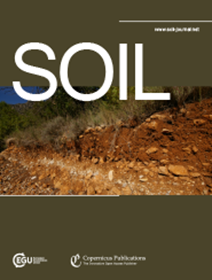森林转化通过改变土壤性质减少了热带雨林的土壤保水
IF 4.3
2区 农林科学
Q1 SOIL SCIENCE
引用次数: 0
摘要
摘要。近几十年来,由于人类活动,大量原始森林正在转变为次生林和人工林,这对土壤水文过程产生了重大影响。然而,人们对森林转化对土壤保水的潜在影响仍然知之甚少。本研究以海南岛热带原生林(PF)、次生林(SF)和橡胶单作林(RM)为研究对象,研究了3种森林类型土壤保水能力的变化及其控制因素。结果表明,原生林的保水能力明显高于次生林和橡胶单一栽培林。次生林在浅层土壤中的保水能力高于橡胶单一林地,而在深层土壤中则低于橡胶单一林地。同样,原生林的土壤蓄水能力也显著高于次生林和橡胶单种,但次生林和橡胶单种存在明显的季节差异,即次生林在雨季的蓄水能力高于橡胶单种,而在旱季则相反。原生林的饱和水导率高于次生林和橡胶单作林。此外,森林类型对土壤性质也有影响,次生林和橡胶单一林地的土壤容重高于原生林,但土壤毛管孔隙率较低。土壤孔隙度是控制土壤保水的主要因素,总孔隙度和毛管孔隙度对保水的贡献率分别为31.49%和30.61%,土壤容重对保水的贡献率相对较小(12.46%)。这些结果表明,热带原生林向次生林和橡胶单一栽培的转变不利于土壤水分的保持和储存。研究结果可为热带雨林的森林开发和管理提供科学依据。本文章由计算机程序翻译,如有差异,请以英文原文为准。
Forest conversion reduces soil water retention in tropical rainforest by altering soil properties
Abstract. Extensive primary forests are being converted to secondary forests and plantation owing to human activities in recent decades, which has substantial effects on soil hydrological processes. However, the potential impact of forest conversion on soil water retention remains poorly understood. In this study, tropical primary forests (PF), secondary forests (SF) and rubber monocultures (RM) converted from tropical primary forests were selected on Hainan Island, to examine the variation in soil water retention across three forest types and their controlling factors. We found that the primary forests exhibited significantly greater water retention capacity than secondary forests and rubber monocultures. However, secondary forests showed higher water retention than rubber monocultures in shallow soils but lower in deep soils. Similarly, primary forests demonstrated significantly greater soil water storage capacity than secondary forests and rubber monocultures, but secondary forests and rubber monocultures had obvious seasonal variations, which showed that secondary forests had a higher water storage capacity than rubber monocultures in the rainy season, and display opposite pattern in the dry season. The saturated hydraulic conductivity in primary forests was higher than that in secondary forests and rubber monoculture. Furthermore, forest types influenced soil properties, with secondary forests and rubber monoculture showing higher bulk density but lower soil capillary porosity compared with primary forests. Among all factors, soil porosity emerged as the dominant controller of water retention, where total porosity and capillary porosity accounted for 31.49 % and 30.61 % of variation respectively, while soil bulk density contributed relatively less (12.46 %). These findings indicate that the conversion of tropical primary forests to secondary forests and rubber monocultures is detrimental to soil water retention and storage. Our results can provide scientific insights for forest development and management in the tropical rainforest.
求助全文
通过发布文献求助,成功后即可免费获取论文全文。
去求助
来源期刊

Soil
Agricultural and Biological Sciences-Soil Science
CiteScore
10.80
自引率
2.90%
发文量
44
审稿时长
30 weeks
期刊介绍:
SOIL is an international scientific journal dedicated to the publication and discussion of high-quality research in the field of soil system sciences.
SOIL is at the interface between the atmosphere, lithosphere, hydrosphere, and biosphere. SOIL publishes scientific research that contributes to understanding the soil system and its interaction with humans and the entire Earth system. The scope of the journal includes all topics that fall within the study of soil science as a discipline, with an emphasis on studies that integrate soil science with other sciences (hydrology, agronomy, socio-economics, health sciences, atmospheric sciences, etc.).
 求助内容:
求助内容: 应助结果提醒方式:
应助结果提醒方式:


